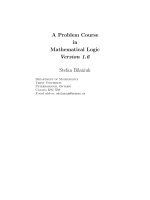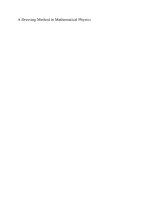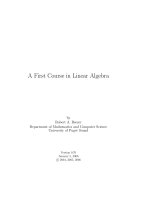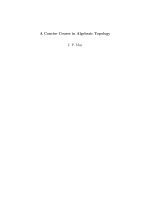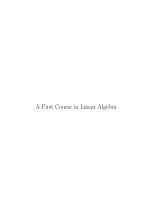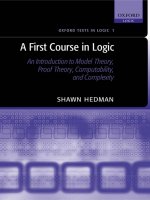A Problem Course in Mathematical Logic Version 1.6 doc
Bạn đang xem bản rút gọn của tài liệu. Xem và tải ngay bản đầy đủ của tài liệu tại đây (726.2 KB, 166 trang )
A Problem Course
in
Mathematical Logic
Version 1.6
Stefan Bilaniuk
Department of Mathematics
Trent University
Peterborough, Ontario
Canada K9J 7B8
E-mail address:
1991 Mathematics Subject Classification. 03
Key words and phrases. logic, computability, incompleteness
Abstract. This is a text for a problem-oriented course on math-
ematical logic and computability.
Copyright
c
1994-2003 Stefan Bilaniuk.
Permission is granted to copy, distribute and/or modify this doc-
ument under the terms of the GNU Free Documentation License,
Version 1.2 or any later version published by the Free Software
Foundation; with no Invariant Sections, no Front-Cover Texts, and
no Back-Cover Texts. A copy of the license is included in the sec-
tion entitled “GNU Free Documentation License”.
This work was typeset with L
A
T
E
X, using the A
M
S-L
A
T
E
Xand
A
M
SFonts packages of the American Mathematical Society.
Contents
Preface v
Introduction ix
Part I. Propositional Logic 1
Chapter 1. Language 3
Chapter 2. Truth Assignments 7
Chapter 3. Deductions 11
Chapter 4. Soundness and Completeness 15
Hints for Chapters 1–4 17
Part II. First-Order Logic 21
Chapter 5. Languages 23
Chapter 6. Structures and Models 33
Chapter 7. Deductions 41
Chapter 8. Soundness and Completeness 47
Chapter 9. Applications of Compactness 53
Hints for Chapters 5–9 59
Part III. Computability 65
Chapter 10. Turing Machines 67
Chapter 11. Variations and Simulations 75
Chapter 12. Computable and Non-Computable Functions 81
Chapter 13. Recursive Functions 87
Chapter 14. Characterizing Computability 95
iii
iv CONTENTS
Hints for Chapters 10–14 101
Part IV. Incompleteness 109
Chapter 15. Preliminaries 111
Chapter 16. Coding First-Order Logic 113
Chapter 17. Defining Recursive Functions In Arithmetic 117
Chapter 18. The Incompleteness Theorem 123
Hints for Chapters 15–18 127
Appendices 131
Appendix A. A Little Set Theory 133
Appendix B. The Greek Alphabet 135
Appendix C. Logic Limericks 137
Appendix D. GNU Free Documentation License 139
Appendix. Bibliography 147
Appendix. Index 149
Preface
This book is a free text intended to be the basis for a problem-
oriented course(s) in mathematical logic and computability for students
with some degree of mathematical sophistication. Parts I and II cover
the basics of propositional and first-order logic respectively, Part III
covers the basics of computability using Turing machines and recursive
functions, and Part IV covers G¨odel’s Incompleteness Theorems. They
can be used in various ways for courses of various lengths and mixes of
material. The author typically uses Parts I and II for a one-term course
on mathematical logic, Part III for a one-term course on computability,
and/or much of Part III together with Part IV for a one-term course
on computability and incompleteness.
In keeping with the modified Moore-method, this book supplies
definitions, problems, and statements of results, along with some ex-
planations, examples, and hints. The intent is for the students, indi-
vidually or in groups, to learn the material by solving the problems
and proving the results for themselves. Besides constructive criticism,
it will probably be necessary for the instructor to supply further hints
or direct the students to other sources from time to time. Just how
this text is used will, of course, depend on the instructor and students
in question. However, it is probably not appropriate for a conventional
lecture-based course nor for a really large class.
The material presented in this text is somewhat stripped-down.
Various concepts and topics that are often covered in introductory
mathematical logic and computability courses are given very short
shrift or omitted entirely.
1
Instructors might consider having students
do projects on additional material if they wish to to cover it.
Prerequisites. The material in this text is largely self-contained,
though some knowledge of (very basic) set theory and elementary num-
ber theory is assumed at several points. A few problems and examples
draw on concepts from other parts of mathematics; students who are
1
Future versions of both volumes may include more – or less! – material. Feel
free to send suggestions, corrections, criticisms, and the like — I’ll feel free to ignore
them or use them.
v
vi PREFACE
not already familiar with these should consult texts in the appropri-
ate subjects for the necessary definitions. What is really needed to
get anywhere with all of the material developed here is competence in
handling abstraction and proofs, including proofs by induction. The
experience provided by a rigorous introductory course in abstract al-
gebra, analysis, or discrete mathematics ought to be sufficient.
Chapter Dependencies. The following diagram indicates how
the parts and chapters depend on one another, with the exception
of a few isolated problems or subsections.
1 10
2 3 11 12
4 13
5 14
6 7 15
8 16 17
9 18
I
II
III
IV
✟
✟
✟
✟
✟✙
❍
❍
❍
❍
❍❥
✟
✟
✟
✟
✟✙
❍
❍
❍
❍
❍❥
❍
❍
❍
❍
❍❥
✟
✟
✟
✟
✟✙
❄
✟
✟
✟
✟
✟✙
❄
✟
✟
✟
✟
✟✙
❍
❍
❍
❍
❍❥
❄
✲
❍
❍
❍
❍
❍❥
✟
✟
✟
✟
✟✙
✟
✟
✟
✟
✟✙
❍
❍
❍
❍
❍❥
❄
❍
❍
❍
❍
❍❥
✟
✟
✟
✟
✟✙
Acknowledgements. Various people and institutions deserve some
credit for this text.
Foremost are all the people who developed the subject, even though
almost no attempt has been made to give due credit to those who
developed and refined the ideas, results, and proofs mentioned in this
work. In mitigation, it would often be difficult to assign credit fairly
because many people were involved, frequently having interacted in
complicated ways. Those interested in who did what should start by
consulting other texts or reference works covering similar material. In
PREFACE vii
particular, a number of the key papers in the development of modern
mathematical logic can be found in [9]and[6].
Others who should be acknowledged include my teachers and col-
leagues; my students at Trent University who suffered, suffer, and will
suffer through assorted versions of this text; Trent University and the
taxpayers of Ontario, who paid my salary; Ohio University, where I
spent my sabbatical in 1995–96; all the people and organizations who
developed the software and hardware with which this book was pre-
pared. Gregory H. Moore, whose mathematical logic course convinced
me that I wanted to do the stuff, deserves particular mention.
Any blame properly accrues to the author.
Availability. The URL of the home page for A Problem Course
In Mathematical Logic, with links to L
A
T
E
X, PostScript, and Portable
Document Format (pdf) files of the latest available release is:
/>Please note that to typeset the L
A
T
E
X source files, you will need the
A
M
S-L
A
T
E
XandA
M
SFonts packages in addition to L
A
T
E
X.
If you have any problems, feel free to contact the author for assis-
tance, preferably by e-mail:
Stefan Bilaniuk
Department of Mathematics
Trent University
Peterborough, Ontario
K9J 7B8
e-mail:
Conditions. See the GNU Free Documentation License in Appen-
dix D for what you can do with this text. The gist is that you are free
to copy, distribute, and use it unchanged, but there are some restric-
tions on what you can do if you wish to make changes. If you wish to
use this text in a manner not covered by the GNU Free Documentation
License, please contact the author.
Author’s Opinion. It’s not great, but the price is right!
Introduction
What sets mathematics aside from other disciplines is its reliance on
proof as the principal technique for determining truth, where science,
for example, relies on (carefully analyzed) experience. So what is a
proof? Practically speaking, a proof is any reasoned argument accepted
as such by other mathematicians.
2
A more precise definition is needed,
however, if one wishes to discover what mathematical reasoning can
– or cannot – accomplish in principle. This is one of the reasons for
studying mathematical logic, which is also pursued for its own sake
and in order to find new tools to use in the rest of mathematics and in
related fields.
In any case, mathematical logic is concerned with formalizing and
analyzing the kinds of reasoning used in the rest of mathematics. The
point of mathematical logic is not to try to do mathematics per se
completely formally — the practical problems involved in doing so are
usually such as to make this an exercise in frustration — but to study
formal logical systems as mathematical objects in their own right in
order to (informally!) prove things about them. For this reason, the
formal systems developed in this part and the next are optimized to
be easy to prove things about, rather than to be easy to use. Natural
deductive systems such as those developed by philosophers to formalize
logical reasoning are equally capable in principle and much easier to
actually use, but harder to prove things about.
Part of the problem with formalizing mathematical reasoning is the
necessity of precisely specifying the language(s) in which it is to be
done. The natural languages spoken by humans won’t do: they are
so complex and continually changing as to be impossible to pin down
completely. By contrast, the languages which underly formal logical
systems are, like programming languages, rigidly defined but much sim-
pler and less flexible than natural languages. A formal logical system
also requires the careful specification of the allowable rules of reasoning,
2
If you are not a mathematician, gentle reader, you are hereby temporarily
promoted.
ix
x INTRODUCTION
plus some notion of how to interpret statements in the underlying lan-
guage and determine their truth. The real fun lies in the relationship
between interpretation of statements, truth, and reasoning.
The de facto standard for formalizing mathematical systems is first-
order logic, and the main thrust of this text is studying it with a
view to understanding some of its basic features and limitations. More
specifically, Part I of this text is concerned with propositional logic,
developed here as a warm-up for the development of first-order logic
proper in Part II.
Propositional logic attempts to make precise the relationships that
certain connectives like not, and, or,andif then are used to ex-
press in English. While it has uses, propositional logic is not powerful
enough to formalize most mathematical discourse. For one thing, it
cannot handle the concepts expressed by the quantifiers all and there
is. First-order logic adds these notions to those propositional logic
handles, and suffices, in principle, to formalize most mathematical rea-
soning. The greater flexibility and power of first-order logic makes it a
good deal more complicated to work with, both in syntax and seman-
tics. However, a number of results about propositional logic carry over
to first-order logic with little change.
Given that first-order logic can be used to formalize most mathe-
matical reasoning it provides a natural context in which to ask whether
such reasoning can be automated. This question is the Entschei-
dungsproblem
3
:
Entscheidungsproblem. Given a set Σ of hypotheses and some
statement ϕ, is there an effective method for determining whether or
not the hypotheses in Σ suffice to prove ϕ?
Historically, this question arose out of David Hilbert’s scheme to
secure the foundations of mathematics by axiomatizing mathematics
in first-order logic, showing that the axioms in question do not give
rise to any contradictions, and that they suffice to prove or disprove
every statement (which is where the Entscheidungsproblem comes in).
If the answer to the Entscheidungsproblem were “yes” in general, the
effective method(s) in question might put mathematicians out of busi-
ness Of course, the statement of the problem begs the question of
what “effective method” is supposed to mean.
In the course of trying to find a suitable formalization of the no-
tion of “effective method”, mathematicians developed several different
3
Entscheidungsproblem ≡ decision problem.
INTRODUCTION xi
abstract models of computation in the 1930’s, including recursive func-
tions, λ-calculus, Turing machines, and grammars
4
. Although these
models are very different from each other in spirit and formal defini-
tion, it turned out that they were all essentially equivalent in what they
could do. This suggested the (empirical, not mathematical!) principle:
Church’s Thesis. A function is effectively computable in princi-
ple in the real world if and only if it is computable by (any) one of the
abstract models mentioned above.
Part III explores two of the standard formalizations of the notion of
“effective method”, namely Turing machines and recursive functions,
showing, among other things, that these two formalizations are actually
equivalent. Part IV then uses the tools developed in Parts II ands III
to answer the Entscheidungsproblem for first-order logic. The answer
to the general problem is negative, by the way, though decision proce-
dures do exist for propositional logic, and for some particular first-order
languages and sets of hypotheses in these languages.
Prerequisites. In principle, not much is needed by way of prior
mathematical knowledge to define and prove the basic facts about
propositional logic and computability. Some knowledge of the natu-
ral numbers and a little set theory suffices; the former will be assumed
and the latter is very briefly summarized in Appendix A. ([10]isa
good introduction to basic set theory in a style not unlike this book’s;
[8] is a good one in a more conventional mode.) Competence in han-
dling abstraction and proofs, especially proofs by induction, will be
needed, however. In principle, the experience provided by a rigorous
introductory course in algebra, analysis, or discrete mathematics ought
to be sufficient.
Other Sources and Further Reading. [2], [5], [7], [12], and [13]
are texts which go over large parts of the material covered here (and
often much more besides), while [1]and[4] are good references for more
advanced material. A number of the key papers in the development of
modern mathematical logic and related topics can be found in [9]and
[6]. Entertaining accounts of some related topics may be found in [11],
4
The development of the theory of computation thus actually began before the
development of electronic digital computers. In fact, the computers and program-
ming languages we use today owe much to the abstract models of computation
which preceded them. For example, the standard von Neumann architecture for
digital computers was inspired by Turing machines and the programming language
LISP borrows much of its structure from λ-calculus.
xii INTRODUCTION
[14] and[15]. Those interested in natural deductive systems might try
[3], which has a very clean presentation.
Part I
Propositional Logic
CHAPTER 1
Language
Propositional logic (sometimes called sentential or predicate logic)
attempts to formalize the reasoning that can be done with connectives
like not, and, or,andif then. We will define the formal language
of propositional logic, L
P
, by specifying its symbols and rules for as-
sembling these symbols into the formulas of the language.
Definition 1.1. The symbols of L
P
are:
(1) Parentheses: ( and ).
(2) Connectives: ¬ and →.
(3) Atomic formulas: A
0
, A
1
, A
2
, , A
n
,
We still need to specify the ways in which the symbols of L
P
can
be put together.
Definition 1.2. The formulas of L
P
are those finite sequences or
strings of the symbols given in Definition 1.1 which satisfy the following
rules:
(1) Every atomic formula is a formula.
(2) If α is a formula, then (¬α)isaformula.
(3) If α and β are formulas, then (α → β)isaformula.
(4) No other sequence of symbols is a formula.
We will often use lower-case Greek characters to represent formulas,
as we did in the definition above, and upper-case Greek characters
to represent sets of formulas.
1
All formulas in Chapters 1–4 will be
assumed to be formulas of L
P
unless stated otherwise.
What do these definitions mean? The parentheses are just punc-
tuation: their only purpose is to group other symbols together. (One
could get by without them; see Problem 1.6.) ¬ and → are supposed to
represent the connectives not and if then respectively. The atomic
formulas, A
0
, A
1
, , are meant to represent statements that cannot
be broken down any further using our connectives, such as “The moon
is made of cheese.” Thus, one might translate the the English sen-
tence “If the moon is red, it is not made of cheese” into the formula
1
The Greek alphabet is given in Appendix B.
3
4 1. LANGUAGE
(A
0
→ (¬A
1
)) of L
P
by using A
0
to represent “The moon is red” and
A
1
to represent “The moon is made of cheese.” Note that the truth
of the formula depends on the interpretation of the atomic sentences
which appear in it. Using the interpretations just given of A
0
and A
1
,
the formula (A
0
→ (¬A
1
)) is true, but if we instead use A
0
and A
1
to interpret “My telephone is ringing” and “Someone is calling me”,
respectively, (A
0
→ (¬A
1
)) is false.
Definition 1.2 says that that every atomic formula is a formula and
every other formula is built from shorter formulas using the connectives
and parentheses in particular ways. For example, A
1123
,(A
2
→ (¬A
0
)),
and (((¬A
1
) → (A
1
→ A
7
)) → A
7
) are all formulas, but X
3
,(A
5
),
()¬A
41
, A
5
→ A
7
,and(A
2
→ (¬A
0
) are not.
Problem 1.1. Why are the following not formulas of L
P
?There
might be more than one reason. . .
(1) A
−56
(2) (Y → A)
(3) (A
7
← A
4
)
(4) A
7
→ (¬A
5
))
(5) (A
8
A
9
→ A
1043998
(6) (((¬A
1
) → (A
→ A
7
) → A
7
)
Problem 1.2. Show that every formula of L
P
has the same number
of left parentheses as it has of right parentheses.
Problem 1.3. Suppose α is any formula of L
P
.Let(α) be the
length of α as a sequence of symbols and let p(α) be the number of
parentheses (counting both left and right parentheses) in α. What are
the minimum and maximum values of p(α)/(α)?
Problem 1.4. Suppose α is any formula of L
P
.Lets(α) be the
number of atomic formulas in α (counting repetitions) and let c(α) be
the number of occurrences of → in α. Show that s(α)=c(α)+1.
Problem 1.5. What are the possible lengths of formulas of L
P
?
Prove it.
Problem 1.6. Find a way for doing without parentheses or other
punctuation symbols in defining a formal language for propositional
logic.
Proposition 1.7. Show that the set of formulas of L
P
is countable.
Informal Conventions. At first glance, L
P
may not seem capable
of breaking down English sentences with connectives other than not
and if then. However, the sense of many other connectives can be
1. LANGUAGE 5
captured by these two by using suitable circumlocutions. We will use
the symbols ∧, ∨,and↔ to represent and, or,
2
and if and only if
respectively. Since they are not among the symbols of L
P
, we will use
them as abbreviations for certain constructions involving only ¬ and
→.Namely,
• (α ∧ β)isshortfor(¬(α → (¬β))),
• (α ∨ β)isshortfor((¬α) → β), and
• (α ↔ β)isshortfor((α → β) ∧ (β → α)).
Interpreting A
0
and A
1
as before, for example, one could translate the
English sentence “The moon is red and made of cheese” as (A
0
∧ A
1
).
(Of course this is really (¬(A
0
→ (¬A
1
))), i.e. “It is not the case that
if the moon is green, it is not made of cheese.”) ∧, ∨,and↔ were not
included among the official symbols of L
P
partly because we can get
by without them and partly because leaving them out makes it easier
to prove things about L
P
.
Problem 1.8. Take a couple of English sentences with several con-
nectives and translate them into formulas of L
P
.Youmayuse∧, ∨,
and ↔ if appropriate.
Problem 1.9. Write out ((α ∨ β) ∧ (β → α)) using only ¬ and →.
For the sake of readability, we will occasionally use some informal
conventions that let us get away with writing fewer parentheses:
• We will usually drop the outermost parentheses in a formula,
writing α → β instead of (α → β)and¬α instead of (¬α).
• We will let ¬ take precedence over → when parentheses are
missing, so ¬α → β is short for ((¬α) → β), and fit the
informal connectives into this scheme by letting the order of
precedence be ¬, ∧, ∨, →,and↔.
• Finally, we will group repetitions of →, ∨, ∧,or↔ to the
right when parentheses are missing, so α → β → γ is short for
(α → (β → γ)).
Just like formulas using ∨, ∧,or¬, formulas in which parentheses have
been omitted as above are not official formulas of L
P
, they are conve-
nient abbreviations for official formulas of L
P
. Note that a precedent
for the precedence convention can be found in the way that · commonly
takes precedence over + in writing arithmetic formulas.
Problem 1.10. Write out ¬(α ↔¬δ)∧ β →¬α → γ first with the
missing parentheses included and then as an official formula of L
P
.
2
We will use or inclusively, so that “A or B” is still true if both of A and B
are true.
6 1. LANGUAGE
The following notion will be needed later on.
Definition 1.3. Suppose ϕ is a formula of L
P
.Thesetofsubfor-
mulas of ϕ, S(ϕ), is defined as follows.
(1) If ϕ is an atomic formula, then S(ϕ)={ϕ}.
(2) If ϕ is (¬α), then S(ϕ)=S(α) ∪{(¬α)}.
(3) If ϕ is (α → β), then S(ϕ)=S(α) ∪S(β) ∪{(α → β)}.
For example, if ϕ is (((¬A
1
) → A
7
) → (A
8
→ A
1
)), then S(ϕ)
includes A
1
, A
7
, A
8
,(¬A
1
), (A
8
→ A
1
), ((¬A
1
) → A
7
), and (((¬A
1
) →
A
7
) → (A
8
→ A
1
)) itself.
Note that if you write out a formula with all the official parenthe-
ses, then the subformulas are just the parts of the formula enclosed by
matching parentheses, plus the atomic formulas. In particular, every
formula is a subformula of itself. Note that some subformulas of for-
mulas involving our informal abbreviations ∨, ∧,or↔ will be most
conveniently written using these abbreviations. For example, if ψ is
A
4
→ A
1
∨ A
4
,then
S(ψ)={ A
1
,A
4
, (¬A
1
), (A
1
∨ A
4
), (A
4
→ (A
1
∨ A
4
)) } .
(As an exercise, where did (¬A
1
)comefrom?)
Problem 1.11. Find all the subformulas of each of the following
formulas.
(1) (¬((¬A
56
) → A
56
))
(2) A
9
→ A
8
→¬(A
78
→¬¬A
0
)
(3) ¬A
0
∧¬A
1
↔¬(A
0
∨ A
1
)
Unique Readability. The slightly paranoid — er, truly rigorous
— might ask whether Definitions 1.1 and 1.2 actually ensure that the
formulas of L
P
are unambiguous, i.e. canbereadinonlyoneway
according to the rules given in Definition 1.2. To actually prove this
one must add to Definition 1.1 the requirement that all the symbols
of L
P
are distinct and that no symbol is a subsequence of any other
symbol. With this addition, one can prove the following:
Theorem 1.12 (Unique Readability Theorem). A formula of L
P
must satisfy exactly one of conditions 1–3 in Definition 1.2.
CHAPTER 2
Truth Assignments
Whether a given formula ϕ of L
P
is true or false usually depends on
howweinterprettheatomicformulaswhichappearinϕ. For example,
if ϕ is the atomic formula A
2
and we interpret it as “2+2 = 4”, it is true,
but if we interpret it as “The moon is made of cheese”, it is false. Since
we don’t want to commit ourselves to a single interpretation — after
all, we’re really interested in general logical relationships — we will
define how any assignment of truth values T (“true”) and F (“false”)
to atomic formulas of L
P
can be extended to all other formulas. We
will also get a reasonable definition of what it means for a formula of
L
P
to follow logically from other formulas.
Definition 2.1. A truth assignment is a function v whose domain
is the set of all formulas of L
P
and whose range is the set {T,F} of
truth values, such that:
(1) v(A
n
) is defined for every atomic formula A
n
.
(2) For any formula α,
v((¬α))=
T if v(α)=F
F if v(α)=T .
(3) For any formulas α and β,
v((α → β))=
F if v(α)=T and v(β)=F
T otherwise.
Given interpretations of all the atomic formulas of L
P
, the corre-
sponding truth assignment would give each atomic formula representing
a true statement the value T and every atomic formula representing a
false statement the value F . Note that we have not defined how to
handle any truth values besides T and F in L
P
. Logics with other
truth values have uses, but are not relevant in most of mathematics.
For an example of how non-atomic formulas are given truth values
on the basis of the truth values given to their components, suppose
v is a truth assignment such that v(A
0
)=T and v(A
1
)=F .Then
v(((¬A
1
) → (A
0
→ A
1
)) ) is determined from v((¬A
1
)) and v((A
0
→
7
8 2. TRUTH ASSIGNMENTS
A
1
) ) according to clause 3 of Definition 2.1. In turn, v((¬A
1
) ) is deter-
mined from of v(A
1
) according to clause 2 and v((A
0
→ A
1
) ) is deter-
mined from v(A
1
)andv(A
0
) according to clause 3. Finally, by clause 1,
our truth assignment must be defined for all atomic formulas to begin
with; in this case, v(A
0
)=T and v(A
1
)=F .Thusv((¬A
1
))= T and
v((A
0
→ A
1
)) =F ,sov(((¬A
1
) → (A
0
→ A
1
)) ) = F .
A convenient way to write out the determination of the truth value
of a formula on a given truth assignment is to use a truth table: list all
the subformulas of the given formula across the top in order of length
and then fill in their truth values on the bottom from left to right.
Except for the atomic formulas at the extreme left, the truth value of
each subformula will depend on the truth values of the subformulas to
its left. For the example above, one gets something like:
A
0
A
1
(¬A
1
) (A
0
→ A
1
) (¬A
1
) → (A
0
→ A
1
))
T F T F F
Problem 2.1. Suppose v is a truth assignment such that v(A
0
)=
v(A
2
)=T and v(A
1
)=v(A
3
)=F .Findv(α) if α is:
(1) ¬A
2
→¬A
3
(2) ¬A
2
→ A
3
(3) ¬(¬A
0
→ A
1
)
(4) A
0
∨ A
1
(5) A
0
∧ A
1
The use of finite truth tables to determine what truth value a par-
ticular truth assignment gives a particular formula is justified by the
following proposition, which asserts that only the truth values of the
atomic sentences in the formula matter.
Proposition 2.2. Suppose δ is any formula and u and v are truth
assignments such that u(A
n
)=v(A
n
) for all atomic formulas A
n
which
occur in δ.Thenu(δ)=v(δ).
Corollary 2.3. Suppose u and v are truth assignments such that
u(A
n
)=v(A
n
) for every atomic formula A
n
.Thenu = v, i.e. u(ϕ)=
v(ϕ) for every formula ϕ.
Proposition 2.4. If α and β are formulas and v is a truth assign-
ment, then:
(1) v(¬α)=T if and only if v(α)=F .
(2) v(α → β)=T if and only if v(β)=T whenever v(α)=T ;
(3) v(α ∧ β)=T if and only if v(α)=T and v(β)=T ;
(4) v(α ∨ β)=T if and only if v(α)=T or v(β)=T ;and
(5) v(α ↔ β)=T if and only if v(α)=v(β).
2. TRUTH ASSIGNMENTS 9
Truth tables are often used even when the formula in question is
not broken down all the way into atomic formulas. For example, if α
and β are any formulas and we know that α is true but β is false, then
the truth of (α → (¬β)) can be determined by means of the following
table:
α
β (¬β) (α → (¬β))
T F T T
Definition 2.2. If v is a truth assignment and ϕ is a formula, we
will often say that v satisfies ϕ if v(ϕ)=T . Similarly, if Σ is a set
of formulas, we will often say that v satisfies Σ if v(σ)=T for every
σ ∈ Σ. We will say that ϕ (respectively, Σ) is satisfiable if there is
some truth assignment which satisfies it.
Definition 2.3. Aformulaϕ is a tautology if it is satisfied by every
truth assignment. A formula ψ is a contradiction if there is no truth
assignment which satisfies it.
For example, (A
4
→ A
4
) is a tautology while (¬(A
4
→ A
4
)) is a
contradiction, and A
4
is a formula which is neither. One can check
whether a given formula is a tautology, contradiction, or neither, by
grinding out a complete truth table for it, with a separate line for each
possible assignment of truth values to the atomic subformulas of the
formula. For A
3
→ (A
4
→ A
3
)thisgives
A
3
A
4
A
4
→ A
3
A
3
→ (A
4
→ A
3
)
T T T T
T
F T T
F
T F T
F
F T T
so A
3
→ (A
4
→ A
3
) is a tautology. Note that, by Proposition 2.2, we
need only consider the possible truth values of the atomic sentences
which actually occur in a given formula.
One can often use truth tables to determine whether a given formula
is a tautology or a contradiction even when it is not broken down all
the way into atomic formulas. For example, if α is any formula, then
the table
α
(α → α) (¬(α → α))
T T F
F
T F
demonstrates that (¬(α → α)) is a contradiction, no matter which
formula of L
P
α actually is.
Proposition 2.5. If α is any formula, then ((¬α) ∨ α) is a tau-
tology and ((¬α) ∧ α) is a contradiction.
10 2. TRUTH ASSIGNMENTS
Proposition 2.6. Aformulaβ isatautologyifandonlyif¬β is
a contradiction.
After all this warmup, we are finally in a position to define what it
means for one formula to follow logically from other formulas.
Definition 2.4. A set of formulas Σ implies aformulaϕ, written
as Σ |= ϕ, if every truth assignment v which satisfies Σ also satisfies ϕ.
We will often write Σ ϕ if it is not the case that Σ |= ϕ.Inthecase
where Σ is empty, we will usually write |= ϕ instead of ∅|= ϕ.
Similarly, if ∆ and Γ are sets of formulas, then ∆ implies Γ, written
as ∆ |= Γ, if every truth assignment v which satisfies ∆ also satisfies
Γ.
For example, { A
3
, (A
3
→¬A
7
) }|= ¬A
7
, but { A
8
, (A
5
→ A
8
) }
A
5
. (There is a truth assignment which makes A
8
and A
5
→ A
8
true,
but A
5
false.) Note that a formula ϕ is a tautology if and only if |= ϕ,
and a contradiction if and only if |=(¬ϕ).
Proposition 2.7. If Γ and Σ are sets of formulas such that Γ ⊆ Σ,
then Σ |=Γ.
Problem 2.8. How can one check whether or not Σ |= ϕ for a
formula ϕ and a finite set of formulas Σ?
Proposition 2.9. Suppose Σ is a set of formulas and ψ and ρ are
formulas. Then Σ ∪{ψ}|= ρ if and only if Σ |= ψ → ρ.
Proposition 2.10. A set of formulas Σ is satisfiable if and only if
there is no contradiction χ such that Σ |= χ.
CHAPTER 3
Deductions
In this chapter we develop a way of defining logical implication
that does not rely on any notion of truth, but only on manipulating
sequences of formulas, namely formal proofs or deductions. (Of course,
any way of defining logical implication had better be compatible with
that given in Chapter 2.) To define these, we first specify a suitable
set of formulas which we can use freely as premisses in deductions.
Definition 3.1. The three axiom schema of L
P
are:
A1: (α → (β → α))
A2: ((α → (β → γ)) → ((α → β) → (α → γ)))
A3: (((¬β) → (¬α)) → (((¬β) → α) → β)).
Replacing α, β,andγ by particular formulas of L
P
in any one of the
schemas A1, A2, or A3 gives an axiom of L
P
.
For example, (A
1
→ (A
4
→ A
1
)) is an axiom, being an instance of
axiom schema A1, but (A
9
→ (¬A
0
)) is not an axiom as it is not the
instance of any of the schema. As had better be the case, every axiom
is always true:
Proposition 3.1. Every axiom of L
P
is a tautology.
Second, we specify our one (and only!) rule of inference.
1
Definition 3.2 (Modus Ponens). Given the formulas ϕ and (ϕ →
ψ), one may infer ψ.
We will usually refer to Modus Ponens by its initials, MP. Like any
rule of inference worth its salt, MP preserves truth.
Proposition 3.2. Suppose ϕ and ψ are formulas. Then { ϕ, (ϕ →
ψ) }|= ψ.
With axioms and a rule of inference in hand, we can execute formal
proofs in L
P
.
1
Natural deductive systems, which are usually more convenient to actually
execute deductions in than the system being developed here, compensate for having
few or no axioms by having many rules of inference.
11
12 3. DEDUCTIONS
Definition 3.3. Let Σ be a set of formulas. A deduction or proof
from Σ in L
P
is a finite sequence ϕ
1
ϕ
2
ϕ
n
of formulas such that for
each k ≤ n,
(1) ϕ
k
is an axiom, or
(2) ϕ
k
∈ Σ, or
(3) there are i, j < k such that ϕ
k
follows from ϕ
i
and ϕ
j
by MP.
A formula of Σ appearing in the deduction is called a premiss.Σproves
aformulaα, written as Σ α,ifα is the last formula of a deduction
from Σ. We’ll usually write α for ∅α,andtakeΣ ∆tomean
that Σ δ for every formula δ ∈ ∆.
In order to make it easier to verify that an alleged deduction really
is one, we will number the formulas in a deduction, write them out in
order on separate lines, and give a justification for each formula. Like
the additional connectives and conventions for dropping parentheses in
Chapter 1, this is not officially a part of the definition of a deduction.
Example 3.1. Let us show that ϕ → ϕ.
(1) (ϕ → ((ϕ → ϕ) → ϕ)) → ((ϕ → (ϕ → ϕ)) → (ϕ → ϕ)) A2
(2) ϕ → ((ϕ → ϕ) → ϕ)A1
(3) (ϕ → (ϕ → ϕ)) → (ϕ → ϕ)1,2MP
(4) ϕ → (ϕ → ϕ)A1
(5) ϕ → ϕ 3,4 MP
Hence ϕ → ϕ, as desired. Note that indication of the formulas from
which formulas 3 and 5 beside the mentions of MP.
Example 3.2. Let us show that { α → β, β → γ }α → γ.
(1) (β → γ) → (α → (β → γ)) A1
(2) β → γ Premiss
(3) α → (β → γ)1,2MP
(4) (α → (β → γ)) → ((α → β) → (α → γ)) A2
(5) (α → β) → (α → γ)4,3MP
(6) α → β Premiss
(7) α → γ 5,6 MP
Hence { α → β, β → γ }α → γ, as desired.
It is frequently convenient to save time and effort by simply referring
to a deduction one has already done instead of writing it again as part
of another deduction. If you do so, please make sure you appeal only
to deductions that have already been carried out.
Example 3.3. Let us show that (¬α → α) → α.
(1) (¬α →¬α) → ((¬α → α) → α)A3
3. DEDUCTIONS 13
(2) ¬α →¬α Example 3.1
(3) (¬α → α) → α 1,2 MP
Hence (¬α → α) → α, as desired. To be completely formal, one
would have to insert the deduction given in Example 3.1 (with ϕ re-
placed by ¬α throughout) in place of line 2 above and renumber the
old line 3.
Problem 3.3. Show that if α, β,andγ are formulas, then
(1) { α → (β → γ),β}α → γ
(2) α ∨¬α
Example 3.4. Let us show that ¬¬β → β.
(1) (¬β →¬¬β) → ((¬β →¬β) → β)A3
(2) ¬¬β → (¬β →¬¬β)A1
(3) ¬¬β → ((¬β →¬β) → β) 1,2 Example 3.2
(4) ¬β →¬β Example 3.1
(5) ¬¬β → β 3,4 Problem 3.3.1
Hence ¬¬β → β, as desired.
Certain general facts are sometimes handy:
Proposition 3.4. If ϕ
1
ϕ
2
ϕ
n
is a deduction of L
P
,thenϕ
1
ϕ
is also a deduction of L
P
for any such that 1 ≤ ≤ n.
Proposition 3.5. If Γ δ and Γ δ → β,thenΓ β.
Proposition 3.6. If Γ ⊆ ∆ and Γ α,then∆ α.
Proposition 3.7. If Γ ∆ and ∆ σ,thenΓ σ.
The following theorem often lets one take substantial shortcuts
when trying to show that certain deductions exist in L
P
, even though
it doesn’t give us the deductions explicitly.
Theorem 3.8 (Deduction Theorem). If Σ is any set of formulas
and α and β are any formulas, then Σ α → β if and only if Σ∪{α}
β.
Example 3.5. Let us show that ϕ → ϕ. By the Deduction
Theorem it is enough to show that {ϕ}ϕ, which is trivial:
(1) ϕ Premiss
Compare this to the deduction in Example 3.1.
Problem 3.9. Appealing to previous deductions and the Deduction
Theorem if you wish, show that:
(1) {δ, ¬δ}γ

